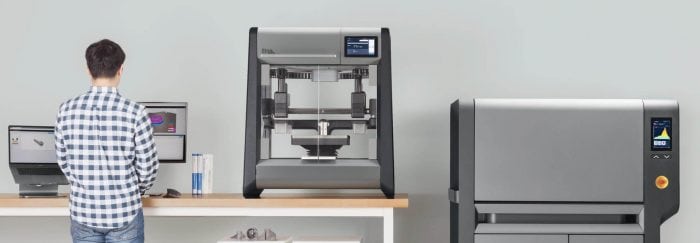The process of 3D printing creates a physical object out of a digital design. It does this by adding materials layer by layer. In the beginning, it was thought that 3D printing would become a novelty for people who wanted to create their own objects out of plastic at home, but this market never took off as expected. Now, the ability to 3D print metal promises to revolutionize the manufacturing industry. There are many reasons why businesses should look to 3D printing as a solution for improving the efficiency of their business, especially if film forming polymers are used to produce the final printing result.
How Old Is This Technology?
Many people think of 3D printing as new technology, but it has actually been around for quite some time. The concept was developed in 1983, but it was only in 2009 that it became more common. 3D printing is what is known as additive manufacturing because materials are continually added with each layer. Since 2009 when the first 3D printers were introduced to the open market, sales have been growing steadily. Currently, there are approximately 300,000 consumer 3D printers operating in the world.
Now, advances in technology allow for the ability to print more than plastic. Any material that can be altered in its physical state can be 3D printed. This means that it is now possible to 3D print metal. The layering process makes it possible to combine metals that were never able to be combined in the past due to their unique properties. This has opened up the world of 3D printing to diverse manufacturing processes. It is now possible to fabricate small parts using 3D printing much more efficiently than using standard manufacturing processes.
The Pros of 3D Printing
Currently, 3D printing technology still lags behind manufacturing processes in some ways, but that is quickly changing. In the future, developers hope that 3D printing will be able to replace many labor-intensive and costly manufacturing processes. 3D printing has several advantages over traditional manufacturing.
- Ability to create complex designs
- Ability to customize each item made
- No tools or molds needed means lower fixed costs
- Faster prototyping with little financial risk
- Less waste than traditional manufacturing
Cons of 3D Printing
The technology for 3D printing is currently limited, which creates a few disadvantages. As technology improves, many of these disadvantages will be eliminated.
- Higher costs for larger product runs
- Currently not as many materials, colors, and finish choices
- Limited strengths and endurances
Some say that 3D printing is not as precise as standard manufacturing, but this is up for debate. Because there is less chance for human error, 3D printing can be more precise, and have greater consistency between parts.
3D Printing and the Supply Chain
Logistics and the supply chain are one of the most important factors for small business growth. The ability to move supplies from one geographic location to another often means the difference between profitability and loss due to operating costs. The need to move parts over large geographic distances can limit the ability for small businesses to grow and larger ones to remain profitable.
With transportation costs rising, businesses are looking for new solutions for improving the efficiency of their supply chain. 3D printing offers a solution to supply chain problems. It is possible to produce many of the small components such as nuts, bolts, and other small items using 3D printing. This means that these components can be produced in-house, saving transportation costs and the potential that supplies will be delayed. This can be essential for operations that use just in time production methods. 3D printing means that you will always have the supply of components when you need it most.
Opening a World of Business Opportunities
Currently, this technology is being used by automobile manufacturers, physicians, dentists, prosthetic device makers, aircraft manufacturers, aerospace companies, movie prop makers, product designers, architects, students, engineers, and manufacturers of all types of consumer products. Those in the design business benefit from the ability to bring prototypes into reality quickly and to get products to market faster than through the old research and design processes.
The potential uses for 3D printing are increasing all the time. In the early days of 3D printers the technology was not able to do everything that it can today. Now, units have become more affordable and many small businesses are seeing the opportunity to use 3D printing in many different types of manufacturing operations.
Manufacturers that specialize in 3D printed components can offer more cost-effective alternatives than their competitors who use standard manufacturing processes. 3D printers can deliver more consistent parts, which cuts down on waste due to quality control issues. The ability to produce parts cheaply, quickly, and with fewer quality control issues is a manufacturer’s dream.
Lower cost for components also means that many smaller businesses can compete on a larger scale than was possible in the past. 3D printing allows the small mom-and-pop shop to become a major competitor on the global market due to reductions in component costs.
Are You Ready for a Game Changer?
The world of 3D printing is set to revolutionize the manufacturing industry. It is expected that by 2020, nearly 75 percent of all manufacturing processes will use the 3D printing process in some phase of the operation. In a recent survey, nearly 47 percent of businesses using 3D printers said that they have seen a significant return on their investment. This is up from those that indicated a return on their investment in previous years. As the cost of printers go down and the technology improves, the return on investment can be expected to be even greater in the future.
The use of 3D printing in manufacturing will help to improve the bottom line of many companies. This is good news for the companies and it is good news for the investors. The ability of 3D printing to cut operational costs and improve quality will have a positive effect on retained earnings in many businesses.
Improvements in the technology of 3D printing are a game changer for the world manufacturing. Of the systems in use currently, approximately 49 percent are being used in the manufacture of metal components. The remainder is in use for production processes using polymers. Manufacturers that adopt the use of 3D printing, either in-house or outsourced, will propel themselves ahead of their competitors that are still relying on old manufacturing methods.
Outsourcing Solutions
Perhaps those who will benefit the greatest from 3D printing are manufacturers who must adapt their components on a part by part basis. 3D printing speeds all of the steps in the manufacturing process from prototyping to completing the production run. It will be the preferred manufacturing process for many different types of parts in the future. Many envision a world where the need to ship parts over long distances becomes obsolete for the most part.
Even though the costs of 3D printing are coming down, they may still be out of reach for some small manufacturers. Companies that outsource 3D printing offer potential solutions to this problem. Finding a supplier who specializes in 3D printing can save you money and assure that the parts are consistently of high quality.
Perhaps the greatest advantage that holds the most potential in the future is the ability of 3D printing to produce unique one-of-a-kind and small run parts. A world has been imagined where items such as cell phones and coffee makers were 3D printed for each individual customer. This is far in the future, but is in the realm of possibilities at some point in time. Click this page for the best 3D printer for miniatures reviews.
If you need a component that is hard to source, 3D printing may offer the solution. Even if you do not foresee yourself purchasing a printer and doing certain phases of the manufacturing process in-house, choosing a manufacturer who uses 3D printing is a cost-effective way to meet the demands of a changing manufacturing environment. 3D printing is an impressive invention and if you are ready to explore what 3D printing can do for you, perhaps it is time to find a supplier who specializes in the latest innovative technology for your business needs.
Find a Home-Based Business to Start-Up >>> Hundreds of Business Listings.
















































